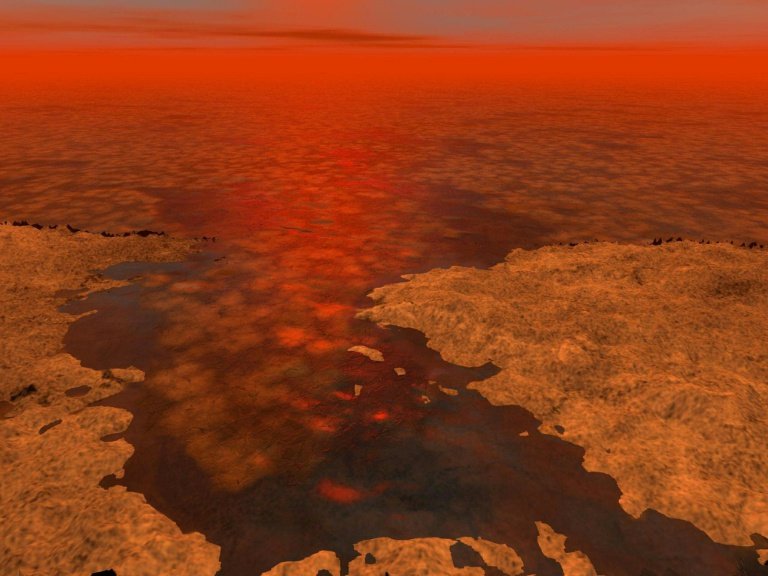NASA will fly a drone to Titan to search for life

An artist’s concept obtained from NASA envisions what hydrocarbon ice forming on a liquid hydrocarbon sea of Saturn’s moon Titan might look like. © NASA/AFP/File
WASHINGTON — For its next mission in our solar system, NASA plans to fly a drone copter to Saturn’s largest moon Titan in search of the building blocks of life, the space agency said Thursday.
The Dragonfly mission, which will launch in 2026 and land in 2034, will send a rotorcraft to fly to dozens of locations across the icy moon, which has a substantial atmosphere and is viewed by scientists as an equivalent of very early-era Earth.
It is the only celestial body besides our planet known to have liquid rivers, lakes and seas on its surface, though these contain hydrocarbons like methane and ethane, not water.
“Visiting this mysterious ocean world could revolutionize what we know about life in the universe, ” said NASA administrator Jim Bridenstine.
“This cutting-edge mission would have been unthinkable even just a few years ago, but we’re now ready for Dragonfly’s amazing flight.”
NASA said the vehicle would have eight rotors and fly like a large drone.
“During its 2.7-year baseline mission, Dragonfly will explore diverse environments from organic dunes to the floor of an impact crater where liquid water and complex organic materials key to life once existed together for possibly tens of thousands of years,” NASA said in a statement.
MORE STORIES
Changes to lobster fishery to help whales might arrive 2021
Politicians’ tweets could get slapped with warning labels
Senior Facebook executive says it would favor regulation
“Its instruments will study how far prebiotic chemistry may have progressed. They also will investigate the moon’s atmospheric and surface properties and its subsurface ocean and liquid reservoirs.

This image released by NASA on Thursday, Oct. 8, 2015, shows the blue color of Pluto’s haze layer in this picture taken by the New Horizons spacecraft’s Ralph/Multispectral Visible Imaging Camera (MVIC). The high-altitude haze is thought to be similar in nature to that seen at Saturn’s moon Titan. This image was generated by software that combines information from blue, red and near-infrared images to replicate the color a human eye would perceive as closely as possible. AP
“Additionally, instruments will search for chemical evidence of past or extant life,” NASA also said.
The craft will land first at the equatorial “Shangri-La” dune, exploring the region in short trips before building up to longer “leapfrog” flights of five miles (8 kilometers).
It will stop along compelling areas to collect samples before finally reaching the moon’s Selk impact crater, where there is evidence of past liquid water, organic materials and energy: a potential primordial stew.
The hope is the lander will eventually fly more than 175 kilometers (108 miles).
Titan’s atmosphere is made mostly of nitrogen, like Earth’s, but is four times denser. Its clouds and rains are methane.
The second-largest moon in the solar system, Titan has a thick water ice crust, beneath which is an ocean made primarily of water.
The underground ocean could harbor life as we know it, while the hydrocarbon lakes and seas on the moon’s surface could contain life forms that rely on different chemistries – or the body could be lifeless.
Titan is about 1.4 billion kilometers (886 million miles) from the Sun, with surface temperatures of around -179 degrees Celsius (-290 degrees Fahrenheit) and surface pressure about 50 percent higher than Earth. /kga
Disclaimer: The comments uploaded on this site do not necessarily represent or reflect the views of management and owner of Cebudailynews. We reserve the right to exclude comments that we deem to be inconsistent with our editorial standards.
